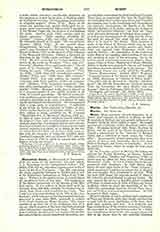

Muratorian Canon, or Muratorian Fragment, after the name of the discoverer and first editor, L. A. Muratori (in the “Antiquitates italicie”, III, Milan, 1740, 851 sq.), the oldest known canon or list of books of the New Testament. The MS. containing the canon originally belonged to Bobbio and is now in the Bibliotheca Ambrosiana at Milan (Cod. J 101 sup.). Written in the eighth century, it plainly shows the uncultured Latin of that time. The fragment is of the highest importance for the history of the Biblical canon. It was written in Rome itself or in its environs about 180-200; probably the original was in Greek, from which it was translated into Latin. This Latin text is preserved solely in the MS. of the Ambrosiana. A few sentences of the Muratorian Canon are preserved in some other MSS., especially in codices of St. Paul’s Epistles in Monte Cassino. The canon consists of no mere list of the Scriptures, but of a survey, which supplies at the same time historical and other information regarding each book. The beginning is missing; the preserved text begins with the last line concerning the second Gospel and the notices, preserved entire, concerning the third and fourth Gospels. Then there are mentioned: The Acts, St. Paul’s Epistles (including those to Philemon, Titus, and Timothy; the spurious ones to the Laodiceans and Alexandrians are rejected); furthermore, the Epistle of St. Jude and two Epistles of St. John; among the Scriptures which “in catholica habentur”, are cited the “Sapientia ab amicis Salomonis in honorem ipsius scripta”, as well as the Apocalypses of St. John and St. Peter, but with the remark that some will not allow the latter to be read in the church. Then mention is made of the Pastor of Hermas, which may be read anywhere but not in the divine service; and, finally, there are rejected false Scriptures, which were used by heretics. In consequence of the barbarous Latin there is no complete understanding of the correct meaning of some of the sentences. As to the author, many conjectures were made (Papias, Hegesippus, Caius of Rome, Hippolytus of Rome, Rhodon, Melito of Sardis were proposed); but no well founded hypothesis has been adduced up to the present. The Muratorian Canon was newly edited by Tregelles, “Canon Muratorianus” (Oxford, 1867); Westcott, “A general survey of the history of the canon” (6th ed., 1889); Buchanan, in “Journal of Theol. Stud.”, VIII (1907), 540-42; Harnack in “Zeitschr.f. Kirchengesch.”, III, 595-99; Preuschen in “Analecta, kürzere Texte zur Geschichte der alten Kirche and des Kanons” (2nd ed., Tubingen, 1910), 27-35; Rauschen, “Florilegium patristicum”, III (Bonn, 1905).
J. P. KIRSCH

